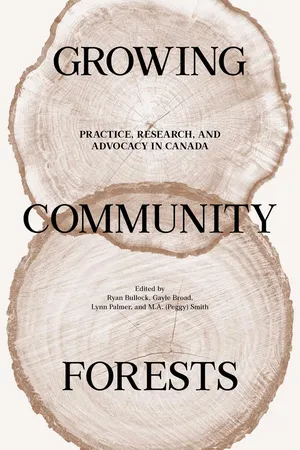Characterizing Institutional Diversity in Canada’s Community Forests
Ryan Bullock, Sara Teitelbaum, and Julia Lawler
Community forestry is a broad term that encompasses initiatives with different origins, institutional forms, and operational practices (Belsky 2008). This diversity is demonstrated in Canada, where community forestry has developed in concert with other forms of industrial and recreational forest development. However, community forests represent a small proportion of Canada’s vast forest lands. The evolution of community forestry in most Canadian provinces is neither linear nor consistent, and many collectives and governments have experimented at one time or another with community-led models of forest management. A growing volume of research provides evidence for the spread and establishment of community forestry operations and concepts, most notably in British Columbia (Benner et al. 2014; Ambus and Hoberg 2011; Bullock et al. 2009; Pinkerton et al. 2008), Ontario (Teitelbaum and Bullock 2012; Bullock and Hanna 2012), and Quebec (Teitelbaum et al. 2006; Masse 2002), but also in Saskatchewan (Beckley and Korber 1996), New Brunswick (Betts 1997), Newfoundland (Roy 1989), and most recently, Nova Scotia (MacLellan and Duinker, Chapter 6).
Much like the varied geographic landscapes that serve as the setting for community forestry in Canada, the social contexts and underlying motivations for local control over forest resources are both diverse and nuanced (Bullock et al. 2009; Furness et al. 2015). Some community forest supporters are motivated by the need for economic development (Murphy, Chretien, and Morin, Chapter 11), and others are driven by a desire to better conserve forests and their resources amid environmental change (see Leslie, Chapter 10; also Furness and Nelson 2012). Some local groups have sought control over nearby forests due to conflict in contentious areas (see Casimirri and Kant, Chapter 4, also Bullock and Hanna 2012). In some settings, local control of forest lands and resources is pivotal to restoring and securing culture, identity, and traditional stewardship roles (see Lachance, Chapter 5; Smith 2013; Passelac-Ross and Smith 2013; Bullock 2012). Many community forestry initiatives combine a number of these and other objectives suited to a particular place. Given these differences, it can be difficult to make generalizations about the underlying values of community forest organizations. Moreover, it can be challenging to identify exactly what distinguishes community forests from other management approaches, particularly given the recent push toward heightened public participation within provincial forest policy frameworks. The term “community forestry” may mean different things to different people, which is not inherently problematic. Nonetheless there is an opportunity to bring greater clarity to the discussion and start distinguishing the different forms community forestry often takes. Other researchers have begun the work of mapping out different conceptual dimensions of community forestry, namely Krogman and Beckley (2002) and later Belsky (2008), which we build upon in this chapter.
As Krogman and Beckley (2002: 111) point out, “part of the problem in assessing community forestry and community forests stems from the fact that these terms are used widely to describe a broad spectrum of conditions, experiments, and institutions.” In the same paper Krogman and Beckley (2002) offer a bimodal typology that includes a simple continuum ranging from total control and benefits at one end to no control and benefits at the other, acknowledging that neither extreme could exist in Canada (or indeed the world). Krogman and Beckley’s (2002) caveat points to the diversity that makes classifying community forests difficult, and the concomitant need for flexible approaches. Likewise, Belsky (2008), writing about community forestry in the U.S., takes a functional approach to analyzing local governance arrangements in order to distinguish Indigenous, municipal, and conservation organization–based community forests using attributes such as access and control, the nature of the community to be represented, organizational form, and ownership. In an earlier paper Beckley (1998) examined the locus and structure of decision making, management objectives, tenure type, as well as the scale of operations and knowledge base applied through industrial, co-managed, community, and small private woodlot forests. These attempts to classify community forestry by organizing key concepts and practical examples highlight that, at its root, community forestry emphasizes enabling involvement of non-conventional actors in forest management and development—involvement in decision making that sets the priorities, values, and actions to be imposed on forests, but also through receipt of various benefits, whether economic, social, or environmental (see Duinker et al. 1991). Enabling meaningful involvement requires governance infrastructure, such as institutions, organizational entities guided by a local vision and objectives. Thus, we examine resident and stakeholder interactions with forests under an array of local or regional arrangements intended to support local involvement through community forest management and development.
We present four main institutional perspectives prominently featured in relevant research on socio-economics and environmental resource governance that enable community forests to be described with more precision based on key distinguishing features. These include:
1. the type of land ownership and property regime(s) under which the community forest initiative operates;
2. the degree of governance rights it holds;
3. the core values and management objectives that drive the organization; and
4. the sorts of organizational models and legal entities used.
In providing a basis for descriptive classification, we are not concerned with delineating the boundaries of what community forestry is or is not. Rather, we map out key features that can enable community forestry practitioners, scholars and policy makers, and students to make better sense of various initiatives that are currently identified under the community forestry “umbrella.” The discussion below outlines four main institutional perspectives and criteria by which differences can be classified. This provides a framework that we elaborate with examples drawn from relevant literature to help readers make sense of the diversity that presently characterizes community forestry in practice. Below, we discuss notions of property, rights, objectives, and organization as conditions that shape community forestry arrangements in Canada.
Land Ownership and Property Rights
Private, Public, and Common Rights to Forest Lands and Resources
While the notion of “property right” can be applied to material (e.g., land) and non-material items (e.g., ideas), in the context of community forestry the concept is usually used in the former sense to refer to a set of rules governing access to and control over lands and resources (see Waldron 2012). The notion that forests and their resources can be considered property which can be held by an individual or group raises questions regarding who the owners are and what exactly it is that is owned. As Luckert et al. (2011: 43) point out in the context of forest resources, “it is rights, never objects, that are owned. A property right permits its holder to use an asset in order to enjoy the resulting stream of benefits subject to certain conditions, obligations, and prohibitions.” Forest resources can be subject to different property rights held by different individuals or groups through time or at the same time.
There are three main categories of property rights used to govern human behaviour regarding scarce and “contested resources” (Waldron 2012), which can be used to understand property right and ownership regimes in Canada’s community forests: common, public/collective, and private. Each arrangement indicates something about how rights are held (i.e., individually or jointly via some representative legal entity), how rights can be exercised (i.e., who decides and benefits), and the relationship between the rights holder(s) and society (i.e., conditions of acceptable use) (Luckert et al. 2011; Waldron 2012).
(1) Common property is available for use by all or any members of a society where rules are established to ensure that one use or user does not stop another (e.g., a woodland that remains accessible for diverse use and users with no prescribed overriding use). In this instance, individuals decide how they use common resources.1
(2) Collective or public property involves permissible uses and users being determined by members of society together in light of social interests linked to the whole and through some form of collective decision-making process and structure. An example of this can be seen in Canada’s provincial Crown forests, which in different places are subject to certain conditions of access and use set out by various representative groups in the public interest.
(3) Private property, on the other hand, confers a higher degree of autonomy whereby use and/or users are decided by individual land/resources holders—with little or no obligation of concern for broader society, where “private individual[s] or groups hold unfettered title to forest land and all its products” (Luckert et al. 2011: 54).
Given the preponderance of public or “Crown” land in Canada (90 percent) (Natural Resources Canada 2014), it is suitable to consider a public-private division of forest property. However, it should be recognized that public agencies representing citizens can and do hold private property, which may even be off limits to the general public. Examples are Ontario Conservation Authorities, which are corporations that manage municipal lands and also lands owned by the corporate body. Another example where the lines blur between different categories of property exists in First Nations with settled land claims in the Northwest Territories, where land titles are held by Indigenous organizations, in this case corporations, on behalf of band members (AANDC 2013). Alternately, where Crown forests are managed by various people or groups, both common and collective/public property rights can be held by different users, for different uses, and under different formal and informal arrangements, even on the same piece of land. Several, often competing, forest users associated with Crown forest resources have been identified, namely, companies that hold long-term timber harvesting rights and management responsibilities transferred from the provinces to them; individuals holding Aboriginal and Treaty rights; other licensees involved in resource taking such as hunters, fishers, tourism operators, loggers, and non-timber forest product harvesters; and finally, users with non-commercial or non-consumptive rights of access such as berry pickers, hikers, canoeists, and the like (Smith 1995).
Such arrangements can make it difficult to observe distinctions among different property rights and ownership regimes, as forest resources and human behaviours on a certain land base can be subject to different institutional arrangements that can confer varying rights simultaneously (discussed in the next section). For example, the recently formed community forest on Cortes Island in BC would have provincial Crown lands being managed collectively as public property insofar as forest management decisions were being made based on the desires of non-Indigenous residents and Klahoose First Nation band members; however, the arrangement would also uphold common property rights for traditional fo...


